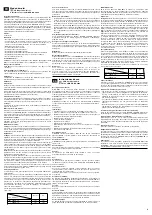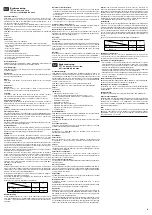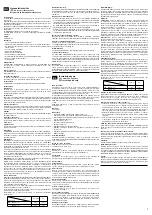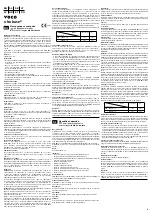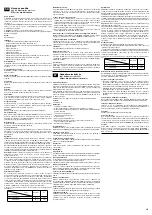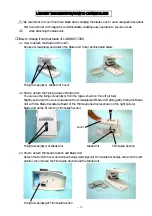
1
Final occlusal layer:
When used as a base / liner
x-tra base
has to be overlayed with an at least
2 mm thick surface layer of a methacrylate-based universal / posterior composite.
For working and finishing directions follow the manufacturer’s instructions for
use.
Warnings, precautionary measures:
– Phenolic substances, especially products containing eugenol and thymol,
lead to curing failures in restorative composites. Consequently, the use of
zinc oxide/eugenol cements or other materials containing eugenol should
be avoided in combination with restorative composites.
– Each
x-tra base
Caps unit should be used for one patient only and should
be applied exerting uniform but not excessive pressure.
– Our information and/or advice do not relieve you of the obligation of
checking that the products supplied by us are suitable for their intended
purpose.
Constituents (in descending order according to content):
Barium aluminium borosilicate glass, BisEMA, TCDDMA, ytterbium trifluoride ,
fumed silica, initiators, stabilisers, pigments
Storage instructions and application method:
Storage at 4°C-23°C. Seal the syringes immediately after removing the
material in order to avoid exposure to light and subsequent polymerisation.
Do not use after the expiry date.
Disposal:
Dispose of the product in accordance with local regulations.
Reporting obligation:
Serious events such as death, temporary or permanent serious deterioration of
a patient’s, user’s or other person’s health condition and a serious risk to public
health that arise or could have arisen in association with the use of
x-tra
base
must be reported to VOCO GmbH and the responsible authority.
Note:
The Summary of Safety and Clinical Performance of
x-tra base
can
be found in the European database on medical devices (EUDAMED –
https://ec.europa.eu/tools/eudamed). Detailed information can also be
found at www.voco.dental.
Produktbeschreibung:
x-tra base
ist ein röntgenopakes, lichthärtendes Flow-Composite, das sich
gegenüber konventionellen Flow-Composites durch eine erhöhte Durch-
härtetiefe bei gleichzeitig reduzierter Schrumpfspannung auszeichnet und
somit eine Inkrementstärke von 4 mm ermöglicht.
Bei der Verwendung als Füllungsbasis muss
x-tra base
okklusal mit einer
mindestens 2 mm starken Deckschicht eines methacrylat-basierten
Universal- oder Seitenzahncomposites überschichtet werden.
x-tra base
wird mit einem Dentin-Schmelzbond angewendet.
x-tra base
enthält
75 Gew.-% anorganische Füllstoffe in einer Methacrylatmatrix.
Farben:
Universal, A2
Indikationen:
–
Unterfüllung (Füllungsbasis) in Kavitäten der Klassen I und II
–
Kavitätenlining, als erste Schicht bei Kavitäten der Klassen I und II
–
Kleine, nicht okklusionstragende Füllungen der Klasse I gemäß der
minimalinvasiven Füllungstherapie
–
Füllungen der Klassen III und V
–
Erweiterte Fissurenversiegelung
–
Ausblocken von Unterschnitten
–
Reparatur kleiner Schmelzdefekte
–
Reparatur kleiner Defekte bei ästhetischen indirekten Restaurationen
–
Reparatur provisorischer K&B-Materialien
–
Stumpfaufbau
Kontraindikationen:
x-tra base
enthält Methacrylate und BHT. Bei bekannten Überempfindlich-
keiten (Allergien) gegen diese Inhaltsstoffe von
x-tra base
ist auf die
Anwendung zu verzichten.
Patientenzielgruppe:
x-tra base
kann für alle Patienten ohne Einschränkung hinsichtlich ihres
Alters oder Geschlechts angewendet werden.
Leistungsmerkmale:
Die Leistungsmerkmale des Produkts entsprechen den Anforderungen der
Zweckbestimmung und den einschlägigen Produktnormen.
Anwender:
Die Anwendung von
x-tra base
erfolgt durch den professionell in der
Zahnmedizin ausgebildeten Anwender.
Anwendung:
Vorbereitung:
Zu behandelnde Zähne reinigen. Gegebenenfalls okklusale Kontaktpunkte
markieren. Vor der Anwendung Material auf Raumtemperatur bringen.
Farbauswahl:
Die Farbauswahl des abschließend für die Okklusalfläche verwendeten
Composites sollte vor der Anästhesie mit dem jeweiligen Farbschlüssel am
gereinigten Zahn erfolgen. Dazu Farbmuster und Zahn anfeuchten und die
Farbe möglichst bei Tageslicht aussuchen.
Kavitätenpräparation:
Grundsätzlich sollte die Kavitätenpräparation nach den Regeln der
adhäsiven Füllungstherapie und minimalinvasiv zur Schonung gesunder
Zahnhartsubstanz erfolgen. Anschließend Kavität reinigen und trocknen.
Trockenlegung:
Für ausreichende Trockenlegung sorgen. Die Verwendung von Kofferdam
wird empfohlen.
Matrize platzieren:
Treffen Sie in Bereichen, wo das gelegte
x-tra base
abfließen kann,
entsprechende Maßnahmen. Vorteilhaft sind transluzente Matrizen, die im
approximalen Bereich verkeilt werden. Minimale Separation erleichtert die
Approximalkontaktgestaltung und das Anlegen der Matrize.
Pulpaschutz:
Im pulpennahen Bereich sollte ein geeigneter Pulpaschutz appliziert werden,
der gegebenenfalls mit einem stabilen Zement überschichtet wird.
Bondmaterial:
x-tra base
wird in der Adhäsivtechnik mit einem Dentin-Schmelzbond
angewandt. Es können alle lichthärtenden Bondingmaterialien verwendet
werden. Bezüglich der Vorbereitung (Ätztechnik) sowie Verarbeitung ist die
jeweilige Gebrauchsanweisung zu beachten.
Applikation:
Spritze:
Beigefügte Applikationskanüle durch Drehen im Uhrzeigersinn auf
der Spritze arretieren und
x-tra base
direkt applizieren. Um die Funktion der
nachlauffreien Spritze zu gewährleisten, ist darauf zu achten, dass während
oder nach der Benutzung der Stempel nicht zurückgezogen werden darf.
Die aufgesetzte Applikationskanüle dient nur dem Einmalgebrauch. Diese nach
Gebrauch abnehmen und die Spritze mit der Originalkappe fest verschließen.
Um die Spritze vor Kontamination durch Körperflüssigkeiten oder ver-
schmutzten Händen oder oralem Gewebe zu schützen, wird die Verwendung
einer Schutzbarriere empfohlen.
Caps:
Schutzkappe entfernen. Caps in die Öffnung des Dispensers (ent-
sprechende Gebrauchsanweisung beachten) einlegen. Metallkanüle in die
gewünschte Richtung biegen.
Material am tiefsten Punkt beginnend direkt in die präparierte Kavität ein-
bringen und die Kavität von unten nach oben auffüllen. Dabei die Spitze
der Metallkanüle eingetaucht lassen. Bei der Applikation auf ein langsames
gleichmäßiges Ausfließen achten, um Luftblasen zu vermeiden. Luftblasen
und Überschüsse ggf. vor der Polymerisation entfernen.
Bei Verwendung als Füllungsbasis muss der Abstand zum okklusalen
Kavitätenrand mindestens 2 mm betragen.
x-tra base
kann in Inkrementen
bis zu einer Stärke von 4 mm polymerisiert werden.
Lichthärtung:
Zur Lichthärtung des Materials sind handelsübliche Polymerisationsgeräte
geeignet. Es ist darauf zu achten, dass jeder Bereich der Füllung
ausreichend belichtet wird. Eine zusätzliche Belichtung von den
zugänglichen Approximalkästen sowie von oral bzw. vestibulär ist
empfehlenswert. Bei Verwendung von Metallmatrizen sind diese dann vorher
zu entfernen. Das Lichtaustrittsfenster der Lampe so nah wie möglich an die
Füllungsoberfläche bringen, sonst ist mit einer schlechteren Durchhärtung
zu rechnen. Eine ungenügende Aushärtung kann zu Verfärbungen des
Materials, zu Festigkeitsverlusten der Compositefüllung und zu Beschwerden
führen.
In Abhängigkeit der Lichtleistung und der gewählten Farbe betragen die
Polymerisationszeiten:
Okklusale Deckschicht:
Bei Verwendung als Füllungsbasis muss
x-tra base
mit einer mindestens
2 mm starken Deckschicht eines methacrylatbasierten Universal- oder
Seitenzahncomposites überschichtet werden. Bezüglich der Verarbeitung
und Ausarbeitung ist die jeweilige Gebrauchsanweisung zu beachten.
Hinweise, Vorsichtsmaßnahmen:
– Phenolische Substanzen, insbesondere eugenol- und thymolhaltige
Präparate führen zu Aushärtungsstörungen der Füllungskunststoffe. Die
Verwendung von Zinkoxid-Eugenol Zementen oder anderer eugenol-
haltiger Werkstoffe in Verbindung mit Füllungskunststoffen ist daher zu
vermeiden.
–
x-tra base
Caps jeweils nur für einen Patienten verwenden. Caps mit gleich-
mäßigem, nicht zu starkem Druck applizieren.
– Unsere Hinweise und/oder Beratung befreien Sie nicht davon, die von uns
gelieferten Präparate auf ihre Eignung für die beabsichtigten Anwendungs-
zwecke zu prüfen.
Zusammensetzung (nach absteigendem Gehalt):
Bariumaluminiumborosilikat Glas, BisEMA, TCDDMA, Ytterbiumtrifluorid,
pyrogenes Siliciumdioxid, Initiatoren, Stabilisatoren, Farbpigmente
Lager- und Anwendungshinweise:
Lagerung bei 4 °C - 23 °C. Spritzen nach der Materialentnahme sofort
verschließen, um Lichteinwirkung und dadurch bedingte Polymerisation zu
verhindern. Nach Ablauf des Verfallsdatums nicht mehr verwenden.
Entsorgung:
Entsorgung des Produkts gemäß den lokalen behördlichen Vorschriften.
Meldepflicht:
Schwerwiegende Vorkommnisse wie der Tod, die vorübergehende oder
dauerhafte schwerwiegende Verschlechterung des Gesundheitszustands
eines Patienten, Anwenders oder anderer Personen und eine schwer-
wiegende Gefahr für die öffentliche Gesundheit, die im Zusammenhang mit
x-tra base
aufgetreten sind oder hätten auftreten können, sind der VOCO
GmbH und der zuständigen Behörde zu melden.
Hinweis:
Kurzberichte über Sicherheit und klinische Leistung für
x-tra base
sind in der Europäischen Datenbank für Medizinprodukte (EUDAMED –
https://ec.europa.eu/tools/eudamed) hinterlegt. Ausführliche Informationen
finden Sie auch unter www.voco.dental.
Product description:
x-tra base
is a radiopaque, light-curing flowable composite. In contrast to
conventional flowables, it is characterised by an increased depth of cure while
at the same time showing reduced shrinkage stress, which means that it can
be cured in layers of 4 mm thickness.
When used as a base/liner
x-tra base
has to be overlayed occlusally with an at least
2 mm thick surface layer of a methacrylate-based universal / posterior
composite.
x-tra base
is used with a dentine enamel bond.
x-tra base
contains
75 % w / w inorganic fillers in a methacrylate matrix.
Shades:
Universal, A2
Indications:
– Base in class I and II cavities
– Cavity lining under direct restorative materials in class I and II cavities
– Small, non occlusal stress-bearing class I restorations according to minimally
invasive filling therapy
– Class III and V restorations
– Extended fissure sealing
– Undercut blockout
– Repair of small enamel defects
– Repair of small defects in aesthetic indirect restorations
– Repair of temporary C&B-materials
– Core build-up
Contraindications:
x-tra base
contains methacrylate and BHT.
x-tra base
should therefore
not be used in patients with a known hypersensitivity (allergy) to these
ingredients.
Patient target group:
x-tra base
is suitable for use in all patients without any age or gender
restrictions.
Performance features:
The product’s performance features satisfy the requirements of the intended
use and the relevant product standards.
User:
x-tra base
should only be used by a professionally trained dental practitioner.
Use:
Preparation:
Clean the teeth being treated. If applicable, mark occlusal contact points.
Bring material to room temperature before use.
Shade selection:
Select a shade of the final composite chosen for the occlusal surface by
comparing the shade guide with the cleaned tooth before anaesthesia.
Moisten the shade sample and the tooth and select the shade, preferably in
daylight.
Cavity preparation:
In principle, the cavities should be prepared according to the rules for
adhesive restorative treatment; preparation should be minimally invasive in
order to protect healthy dental hard tissue. Then clean and dry the cavity.
Creating a dry working field:
Ensure that the work area is sufficiently dry. Use of a rubber dam is
recommended.
Matrix placement:
Take appropriate measures for areas where the applied
x-tra base
can flow away. Translucent matrices that are wedged in the approximal
area are advantageous. Minimal separation facilitates the shaping of the
approximal contact and placement of the matrix.
Pulp protection:
A suitable pulp-protective liner that can be covered with a stable cement, if
necessary, should be applied in close proximity to the pulp.
Bonding materials:
x-tra base
is applied with a dentine enamel bond, using the adhesive
technique. Any light-curing bonding materials can be used. Observe the
relevant instructions for use during preparation (etching technique) and
processing.
Application:
Syringe:
Lock the enclosed intraoral tip on the syringe with a clockwise turn and
directly apply
x-tra base
. In order to guarantee the functionality of the non-
dripping syringe do not pull back the plunger during or after use.
The attached application tip is intended for single use only. Remove it after
use and seal the syringe again tightly with its original cap. The use of a pro-
tective barrier is recommended to protect the syringe against contamination
with bodily fluids, dirt from hands or oral tissue.
Caps:
Remove protective cap. Insert Caps into the opening of the dispenser
(following the instructions for use). Bend the metal cannula into the desired
direction.
Begin applying the material directly into the prepared cavity at the deepest
point and fill the cavity from bottom to top. Keep the tip of the metal cannula
immersed all times. To prevent the formation of air bubbles ensure a slow,
even flow. If necessary, air bubbles or excess material can be removed
before polymerisation. When used as a base/liner the distance to the occlusal
margin of the cavity must be at least 2 mm.
x-tra base
can be polymerised in
increments of up to 4 mm.
Light-curing:
Conventional polymerisation devices are suitable for light-curing the
material. Ensure that all areas of the filling are sufficiently light-cured.
Additional light-curing of the accessible approximal areas and from the oral
as well as the vestibular side is recommended. If metal matrices are used,
these should be removed prior to additional light-curing. Hold the light
emission tip of the device as close as possible to the surface of the
filling. Otherwise, the curing depth may be reduced. Incomplete curing may lead
to discolouration of the material, loss of stability of the composite filling and
discomfort.
Depending on the light output and the chosen shade the curing times are:
x-tra base
®
Instructions for use
EU Medical device
In accordance with DIN EN ISO 4049
EN
Gebrauchsanweisung
EU Medizinprodukt
Entspricht DIN EN ISO 4049
DE
Farbe
universal A2
Lichtleistung
500 - 800 mW/cm
2
10 s 40 s
> 800 mW/cm
2
10 s
20 s
Shade
universal A2
Light output
500 - 800 mW/cm
2
10 s 40 s
> 800 mW/cm
2
10 s
20 s


